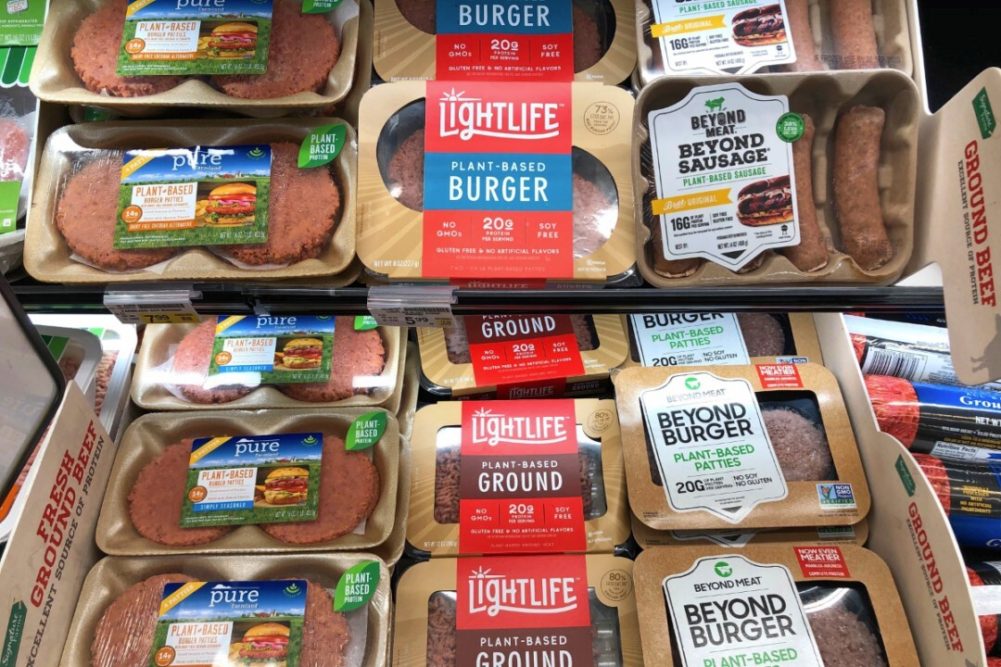Plant-based meat alternatives exploded on the food scene with manufacturers promising an eventual end to factory farming and a better-for-you and save-the-planet health halo. Major retailers and foodservice operators added plant-based burgers, sausages, crumbles and other formats to satisfy consumer demand.
And consumers bought into the message of plant-based meat alternatives — all of the flavor, texture and nutritional benefits of animal proteins without killing animals. The 2022 Power of Meat study, presented by Anne-Marie Roerink, principal of 210 Analytics, San Antonio, Texas, during a recent webinar hosted by the North American Meat Institute and FMI – The Food Industry Association and sponsored by Sealed Air, reported total store plant-based meat alternative sales were $760 million in 2019, representing growth of 11.8% over the prior year.
Plant-based plateau
But the engine driving growth in sales of plant-based meat alternatives seems to have sputtered. The 2022 Power of Meat study revealed that plant-based meat alternatives remain mostly an occasional choice with only 9% of respondents eating them weekly, according to the study. Meat eaters also prepare plant-based meat alternatives, but less often.
“Refrigerated and frozen plant-based meat alternative sales hit a plateau in the second quarter of 2021 and started decreasing in the third and fourth quarters, with fewer trips (-3.6%) and lower spend per trip (-1.1%),” the study said citing data from IRI.
Roerink noted that meat department sales were close to $82 billion in 2021, compared with roughly $500 million in sales of refrigerated meat alternatives which were 4.4% higher than in 2020.
“We have gotten used to those double- and triple-digit growth rates,” Roerink said. “What we saw really throughout 2021 is a decline, a deceleration, of those growth rates; and they actually started to go negative as of the third quarter of 2021.
“We have to keep in mind they’re going up against very, very high growth rates from the year before,” she added. “We had an additional 28% in items the year before, whereas ’21 only benefited from about a 5% increase in items, so it was really the same assortment that had to drive those increases.”
Plant-based meats also didn’t have the inflation that occurred on the conventional meat side, Roerink said, and a lot greater share of plant-based items were sold on promotion.
“Those are some of the reasons why we’re starting to see a deceleration, if not a decrease, in growth rates year over year,” she concluded.
The deceleration of sales growth gave some food companies pause to reconsider their strategies for plant-based product sales. In February, Maple Leaf Foods Inc., which owns the Field Roast and Lightlife brands, said the company began a category review to better understand market trends. Based on that review, company leadership decided that the Plant Protein Group will be pivoting from investing for growth to profitable growth with an objective that the business unit will become adjusted EBITDA neutral or better within 18 months.
Curtis Eugene, president and chief operating officer, said during a Feb. 24 conference call to discuss fiscal 2021 results that the plant-based meat alternative category has “strong underlying steady growth.”
“So, while we see the category growing, we expect it to be at a more moderate but still attractive pace,” Eugene said. “We estimate the category will grow on average of 10% to 15% per year, reaching a market size of approximately $6 billion to $10 billion by 2030.”
Reluctance rules
And while consumers express their willingness to try plant-based meat alternatives, the same can’t be said for cultivated or cell-based meats. The Power of Meat study found that consumers remain somewhat skeptical about cultivated meat with 40% unwilling to try it.
“On the other end of the spectrum, we had 29% who said they were willing” to try cultured meats. “And again, you saw much more willingness among younger shoppers who also tend to struggle a little more with the idea of animal protein,” Roerink said.
Bridge with blends
So, with consumers cooling on plant-based meat alternatives and placing a hard stop on cultured meat, blended items stand out as a format with potential for success with consumers.
Blended items have much greater cross-population appeal, whether across ages, ethnicities, regions or other. Blended items are also a favorite among core value-added meat consumers and those who emphasize meat choices that keep the planet, animal welfare and health in mind.
“Blended vegetable/meat items may be a bridge to keep meat on the plate with a higher level of permissibility,” the Power of Meat study said. “Additionally, the user bases have a large overlap with value-added meat consumers. This provides insight into possible placement as well as the opportunity to leverage value-added sales data at the store level to determine potential interest and placement.”


